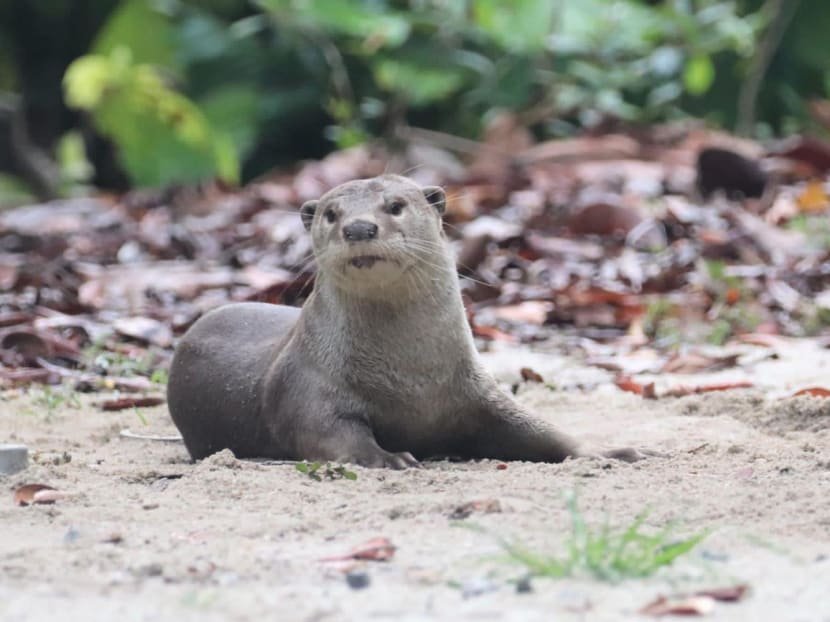Otters could be moved out of housing estates, as part of efforts to reduce potential human-wildlife conflict

NParks
- The authorities have acknowledged that there have been a “number of encounters” between smooth-coated otters and residents recently
- NParks and the Otter Working Group are looking at ways to allow otters and humans to co-exist peacefully
- This includes setting up barriers to prevent entry by the otters into the homes of residents and relocating the mammals
- The smooth-coated otter population has risen to about 170 from about 150 last year
SINGAPORE — The authorities and wildlife volunteers have launched efforts to reduce potential conflict between residents and smooth-coated otters after numerous encounters between the amphibious carnivores and people living near the habitats.
These measures include moving otters out of residential estates to areas where they can have access to their natural food sources, Senior Minister of State for Communications and Information and National Development Tan Kiat How said on Monday (Oct 17).
Steps to keep otters out of estates in the first place include meshing up gaps in gates and erecting otter-proof barriers for ponds, added Mr Tan in a Facebook post.
He said that while the smooth-coated otters largely stay within Singapore’s waterways, they do occasionally visit residential properties with ponds as “the fish there are easy prey for them”.
Otters have been in the headlines in recent months after encounters between residents and the creatures, and an attack on a visitor to the Singapore Botanical Gardens who was bitten 26 times in November last year.
This year, there were reports of the mammals feasting on expensive pet fish after finding their way in the homes of the owners.
Earlier media reports said, for instance, that in March this year a man living in Seletar Hills lost eight koi fish and 50 goldfish. And this month, another fishkeeper in Bukit Timah reportedly lost more than 40 kois and other fish varieties to otters.
TODAY spoke to several residents at Seletar Hills Estate on Monday.
A 69-year-old resident who wanted to be known only as Mr Neo, said that he first saw otters near his semi-detached house in March, and that they had eaten all of the fish in his pond multiple times since then. The most recent incident was in late May.
"I can't prevent them; I just buy cheaper fish nowadays," he added in Chinese. Mr Neo is the boss of a transport company.
Madam Lee Geok Heok, a 63-year-old housewife, said that otters used to be around her semi-detached house on a daily basis, but the last time she saw them was around June.
Mr Phung, a contractor who declined to give either his age or his full name, said that he used to have around 20 to 30 fish that were eaten by otters, but added that he hadn't seen any otters since he installed wire fencing on the gates of his home.
The otter population in Singapore has risen about 13 per cent since last year.
TODAY reported in December that the population of smooth-coated otters in Singapore had nearly doubled to about 150 in the past four years.
The National Parks Board (NParks) said on Monday that there are now about 170 otters in about 17 families with the Bishan, Marina and Zouk groups being the more prominent of those.
It added that in 2020 and 2021, it received 208 and 305 instances of public feedback respectively — including complaints and expressions of general concern about the mammals.
Some hot spots for feedback include residential areas such as Seletar, Bukit Timah and areas along the Alexandra canal.
Mr Tan said that NParks and the Otter Working Group (OWG) have been working with homeowners and estate managers in affected areas to implement the measures.
OWG is a volunteer group that includes various government agencies, Animal Concerns Research & Education Society and the Mandai Wildlife Group.
Said Mr Tan: “With these measures in place, the otters are likely to move on as they are unable to access the ponds for food.”
Some areas which have natural sources of food for otters include Singapore’s waterways, nature reserves, gardens and parks.“
With these measures in place, the otters are likely to move on as they are unable to access the ponds for food.
Senior Minister of State for Communications and Information and National Development Tan Kiat How
”
Mr Tan added that both NParks and OWG are also monitoring otters that have established holts — burrows where they live — within residential estates.
NParks said such groups generally consist of two to three adult otters that have split off from the larger families.
In instances where the otters are unable to access their natural food sources, Mr Tan said NParks will work with the OWG to transfer the otters out of the estate to an area where they have access to their natural food sources.
“This is for the welfare of these otters and to mitigate any issues that could arise from human-wildlife encounters,” he said.
One such transfer operation, added Mr Tan, was carried out in the Seletar area last week as the holt was within a residential estate and isolated from the otters’ natural food sources. This involved three adult otters, and three pups. A holt refers to a burrow where otters live.
Prior to the operation, NParks and OWG monitored the otters to both assess their suitability for transfer and to help them plan for the operation.
NParks said that this allowed them to understand the otters’ behaviour patterns better, such as the time of the day the animals are active.
To secure the otters, perimeter fencing was installed around the holt, and once the otters were secured, they were transferred to an area where they have access to their natural food sources.
Veterinarians were involved to ensure the health and welfare of the otters.
“The otters are being monitored at their new holt,” said Mr Tan, though he did not provide details of where they are now.
Commenting on the news in a Facebook post later on Monday, otter expert N Sivasothi described the transfer operation as "exceptional and non-ideal". Mr Sivasothi is the founder of OtterWatch, a community that shares news about the animal, and is part of the OWG.
The senior lecturer at the National University of Singapore department of biological sciences, whose research interests include these semi-aquatic carnivores, added that this group of otters had faced territorial challenges in Sungei Punggol, and had sought refuge in Seletar Hills where they eventually subsisted on a "sub-optimal diet of pet fish".
Speaking to TODAY on Monday, Mr Sivasothi said the transfer creates a "vacuum effect" in which the reasons for attracting the otters are not addressed. He added that such operations can also lead to accidents, or add stress on the otters since they have pups.
In his post, he said action had to be taken immediately, however, because the otters had dug a natal holt right under a bottleneck pathway with heavy use by residents. It was also right next to a busy road.
The long-term solution, he said, is still the adoption of exclusion measures such as otter-proof barriers.
Mr Sivasothi previously told TODAY that Singapore’s clean waterways provide the right environment for large fish such as tilapia to spawn, and this bountiful food source in turn created an ideal condition for smooth-coated otters to thrive.
Smooth-coated otters are listed as vulnerable on the International Union for Conservation of Nature (IUCN) Red List.
Sharing the same IUCN Red List status is another species of otters found in Singapore, the Asian small-clawed otter. These otters are generally less seen by the public and are typically found in Pulau Ubin and Tekong.
NParks said that in Singapore’s urban environment, smooth-coated otter populations are limited by environmental limits, referred to as the “carrying capacity” of the area, and the availability of suitable habitats.
“As (smooth-coated) otters are highly territorial, competition for space and mortality will further limit how much the populations can grow,” said NParks.
In any case, due to its vulnerable status, NParks said on Monday that their “co-existence with humans in cities like Singapore may be a lifeline for this species”.




